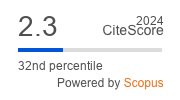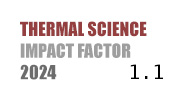THERMAL SCIENCE
International Scientific Journal
Thermal Science - Online First
online first only
Enhancement of PV panel's power using closed back side cooling system and numerical simulation
ABSTRACT
The efficiency of photovoltaic (PV) panels is significantly influenced by the temperature of the cells, as higher temperatures reduce electrical power output, degrade performance, and shorten the panel's lifespan. This study investigates the effectiveness of a closed-loop cooling system applied to the backside of a PV panel to enhance its output characteristics. The cooling system circulated approximately 20 liters of water at a constant flow rate of 70 L/h. The results demonstrated a substantial 41.75% increase in power output, with the maximum efficiency achieved at peak cooling. Using real weather data recorded during the experiment, the temperature distribution across the panel layers was modeled using the ANSYS FLUENT 2023 R1 software package. The simulation and experimental results showed a maximum temperature difference of 1.6°C between the measured and simulated values. The cooled panel maintained an average temperature of 26.65 °C, with a minimum of 16.7°C, compared to an uncooled panel's higher temperatures. The system effectively reduced the temperature of the front side of the panel by up to 23.1°C, enhancing the overall energy output. These findings confirm that cooling PV panels from the back is an efficient method to reduce temperature and increase panel efficiency. Detailed simulations and analyses enable insight into PVT system performance and forecasting of production under various climatic conditions.
KEYWORDS
PAPER SUBMITTED: 2024-12-18
PAPER REVISED: 2025-02-18
PAPER ACCEPTED: 2025-02-21
PUBLISHED ONLINE: 2025-04-05
- Al-Waeli, et al., An experimental investigation of SiC nanofluid as a base-fluid for a photovoltaic thermal PV/T system, Energy Conversion and Management, 142 (2017), pp. 547-558
- Dwivedi, P., Advanced cooling techniques of PV modules: A state of art, Case studies in thermal engineering, 21 (2020), 100674
- Muneeshwaran, M., et al., Performance improvement of photovoltaic modules via temperature homogeneity improvement, Energy, 203 (2020), 117816
- Aboagye, B., et al., Investigation into the impacts of design, installation, operation and maintenance issues on performance and degradation of installed solar photovoltaic (PV) systems, Energy for Sustainable Development, 66 (2022), pp. 165-176
- Moharram, K. A., et al., Enhancing the performance of photovoltaic panels by water cooling, Ain Shams Engineering Journal, 4(4) (2013), pp. 869-877
- Al-Jamea, D. M. K., et al., Investigation on Water Immersing and Spraying for Cooling PV Panel, International Review of Mechanical Engineering (I.RE.M.E.), 16 (2022)
- Kumar, R. S., et al., A Detailed Mathematical Modelling and Experimental Validation of Top Water Cooled Solar PV Module, FME Transactions, 47(3) (2019)
- Choi, S. U., Eastman, J. A., Enhancing thermal conductivity of fluids with nanoparticles (No. ANL/MSD/CP-84938; CONF-951135-29). Argonne National Lab.(ANL), Argonne, IL, United States, 1995
- Prasher, R., et al., Thermal conductivity of nanoscale colloidal solutions (nanofluids), Physical review letters, 94(2) (2005), 025901
- Elmir, M., et al., Numerical simulation of cooling a solar cell by forced convection in the presence of a nanofluid, Energy Procedia, 18 (2012), pp. 594-603
- Menon, G. S., et al., Experimental investigations on unglazed photovoltaic-thermal (PVT) system using water and nanofluid cooling medium, Renewable Energy, 188 (2022), pp. 986-996
- Rejeb, O., et al., Numerical and model validation of uncovered nanofluid sheet and tube type photovoltaic thermal solar system, Energy Conversion and Management, 110 (2016), pp. 367-377
- Selmi, M., et al., Validation of CFD simulation for flat plate solar energy collector, Renewable energy, 33(3) (2008), pp. 383-387
- Attia, M. E. H., et al., Design and performance optimization of a novel zigzag channeled solar photovoltaic thermal system: Numerical investigation and parametric analysis, Journal of Cleaner Production, 434 (2024), 140220
- Khelifa, A., et al., Numerical analysis of the heat transfer and fluid flow of a novel waterbased hybrid photovoltaic-thermal solar collector integrated with flax fibers as natural porous materials, Renewable Energy, 217 (2023), 119245
- He, W., et al., Experimental study and performance analysis of a thermoelectric cooling and heating system driven by a photovoltaic/thermal system in summer and winter operation modes, Energy conversion and management, 84 (2014), pp. 41-49
- Attia, M. E. H., et al., Numerical analysis and design of a novel solar photovoltaic thermal system using finned cooling channel structures embedded with air/TiO2-water nano bi-fluid, Solar Energy, 269 (2024), 112368
- Bahaidarah, H., et al., Performance evaluation of a PV (photovoltaic) module by back surface water cooling for hot climatic conditions, Energy, 59 (2013), pp. 445-453
- Muslim, N. H., et al., Enhancement of solar photovoltaic module performance by using a water-cooling chamber for climatic conditions of Iraq, International Journal of Renewable Energy Research (IJRER), 10(3) (2020), pp. 1103-1110
- Fakouriyan, S., et al., Experimental analysis of a cooling system effect on photovoltaic panels' efficiency and its preheating water production, Renewable Energy, 134 (2019), pp. 1362-1368
- Mohammed, F. M., et al., Performance enhancement of photovoltaic panel using Double-sides water glazing chambers cooling technique, Al-Nahrain Journal for Engineering Sciences, 22(1) (2019), pp. 22-30
- Ansys Fluent User's Guide, ANSYS Inc, USA, Canonsburg, (2022)
- Balafas G. Polyhedral mesh generation for CFD-analysis of complex structures. Master Thesis. Tehnical University of Munich, Munich, (2014)
- Murali, S., et al., Design and performance evaluation of solar-LPG hybrid dryer for drying of shrimps, Renewable Energy, 147(2020), pp. 2417-2428
- Murali, S., et al., Mathematical modeling of drying kinetics and quality characteristics of shrimps dried under a solar-LPG hybrid dryer, Journal of Aquatic Food Product Technology, 30(5) (2021), pp. 561-578
- Murali, S., et al., Drying kinetics and quality characteristics of Indian mackerel (Rastrelliger kanagurta) in solar-electrical hybrid dryer, Journal of Aquatic Food Product Technology, 28(5) (2019), pp. 541-554
- Sardarabadi, M., Passandideh-Fard, M., Experimental and numerical study of metaloxides/ water nanofluids as coolant in photovoltaic thermal systems (PVT), Solar Energy Materials and Solar Cells, 157(2016), pp. 533-542
- Alzaabi, A. A., et al., Electrical/thermal performance of hybrid PV/T system in Sharjah, UAE. International Journal of Smart Grid and Clean Energy, 3(4) (2014), pp. 385-389
- Yu, Y., et al., Testing and modelling an unglazed photovoltaic thermal collector for application in Sichuan Basin. Applied Energy, 242 (2019), pp. 931-941
- Nasrin, R., et al., Water/MWCNT nanofluid based cooling system of PVT: Experimental and numerical research, Renewable energy, 121 (2018), pp. 286-300
- Aste, N., et al., Performance monitoring and modeling of an uncovered photovoltaic-thermal (PVT) water collector. Solar Energy, 135 (2016), pp. 551-568

